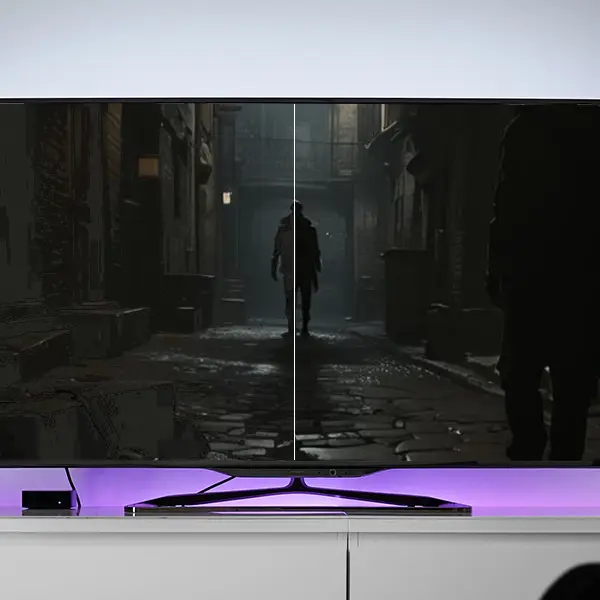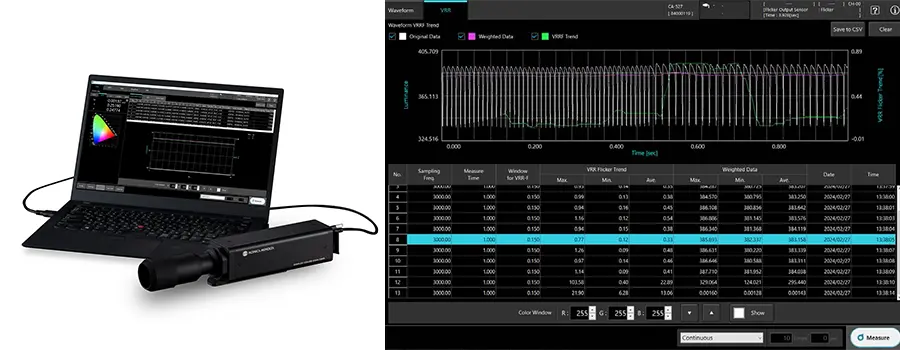Pengukuran Kedipan pada Tampilan Variable Refresh Rate (VRR)

Teknologi Variable Refresh Rate (VRR) merupakan kemajuan signifikan dalam teknologi tampilan, yang secara dinamis menyesuaikan kecepatan refresh monitor, laptop, TV, telepon pintar, dan perangkat serupa secara real-time agar selaras dengan frame rate konten yang ditampilkan. Sinkronisasi ini meminimalkan artefak visual seperti layar yang sobek dan tersendat, sehingga menghasilkan pengalaman menonton yang lebih lancar dan lebih mendalam, khususnya dalam game dan konten video bertempo cepat.
Selain itu, salah satu manfaat utama VRR adalah efisiensi daya. Saat melihat konten statis, seperti gambar atau halaman web, kecepatan refresh dapat diturunkan untuk mengurangi konsumsi daya, sehingga meningkatkan kinerja baterai. Dengan memungkinkan layar melakukan refresh pada kecepatan yang bervariasi daripada mengikuti kecepatan yang tetap, VRR memungkinkan gerakan yang lebih mulus dan lancar, sehingga meningkatkan kualitas keseluruhan pengalaman visual.
Meskipun teknologi VRR menawarkan manfaat yang signifikan, teknologi ini juga menghadirkan potensi kekurangan yang dikenal sebagai kedipan layar VRR. Kedipan ini terwujud sebagai fluktuasi yang nyata dalam kecerahan atau stabilitas gambar yang terjadi saat kecepatan refresh disesuaikan secara dinamis. Variasi tersebut dapat mengganggu dan dapat menyebabkan ketidaknyamanan visual, terutama selama adegan dengan perubahan kecerahan yang halus atau bertahap. Kedipan layar VRR dapat terjadi dalam berbagai teknologi tampilan, seperti Layar OLED, LCD, dsb., yang mana penyesuaian kecepatan penyegaran yang cepat dapat menciptakan pencahayaan yang tidak merata, sehingga kedipan menjadi lebih kentara.
Tantangan dalam Mengukur Kedipan pada Tampilan VRR
Mengukur kedipan layar VRR (Variable Refresh Rate) sangat penting bagi produsen yang ingin memberikan pengalaman menonton yang konsisten dan nyaman bagi konsumen. Kedipan dapat memengaruhi kepuasan pengguna dan kenyamanan visual secara signifikan, sehingga metode pengukuran yang akurat menjadi penting. Selama bertahun-tahun, beberapa teknik pengukuran kedipan telah dikembangkan, dengan metode kedipan JEITA (Japan Electronic Information Technology Association) muncul sebagai salah satu pendekatan yang paling banyak digunakan. Metode ini khususnya efektif untuk tampilan dengan kecepatan refresh statis, di mana bentuk gelombang dapat diprediksi dan periodik.
Namun, metode kedipan JEITA kurang efektif jika diterapkan pada layar VRR, yang dirancang untuk menyesuaikan kecepatan refresh secara dinamis agar sesuai dengan konten yang ditampilkan. Tidak seperti layar statis, layar VRR menunjukkan bentuk gelombang yang aperiodik dan lebih kompleks, sehingga mempersulit pengukuran kedipan. Selain itu, metode kedipan JEITA berfokus pada satu komponen frekuensi, seperti 30 Hz, sehingga membatasi efektivitasnya. Sebaliknya, layar VRR dapat menunjukkan kombinasi beberapa komponen frekuensi, misalnya, 30 Hz dikombinasikan dengan 20 Hz, sehingga membuat pengukuran kedipan menjadi lebih menantang.
Solusi Metrologi Konica Minolta Sensing Display untuk Tampilan VRR
Untuk mengatasi tantangan yang terkait dengan pengukuran kedipan pada tampilan Variable Refresh Rate (VRR) secara efektif, Konica Minolta Sensing telah mengembangkan Penganalisis Warna Tampilan CA-527 Instrumen pengukuran tampilan yang inovatif ini memungkinkan pengukuran kedipan yang akurat dan andal pada tampilan VRR, menawarkan wawasan penting bagi produsen yang dapat meningkatkan kinerja visual produk mereka secara signifikan.

Display Color Analyzer CA-527 dilengkapi fungsi pengukuran kedipan VRR yang dirancang untuk meningkatkan akurasi penilaian kedipan pada tampilan VRR. Tidak seperti metode tradisional yang beroperasi dalam domain frekuensi, alat ini menggabungkan Fungsi Sensitivitas Kontras Temporal (TCSF) dalam domain waktu berdasarkan IEC 62341-6-3, yang menawarkan pengukuran kedipan yang lebih kuat dan konsisten. Selain itu, alat ini memperhitungkan interaksi antara berbagai komponen frekuensi, yang selanjutnya meningkatkan efektivitasnya.
Selain kemampuan khusus untuk mengukur kedipan VRR, Display Color Analyzer CA-527 menawarkan berbagai metode pengukuran kedipan lainnya untuk memenuhi berbagai persyaratan. Metode ini meliputi teknik JEITA, VESA (Video Electronics Standards Association), dan FMA (Flicker Modulation Amplitude). Display Color Analyzer CA-527 juga menawarkan kemampuan ekstensif dalam mengukur luminansi dan kromatisitas pada rentang dinamis yang lebar, yang ideal untuk mengevaluasi keseragaman luminansi dan kromatisitas, gamut warna, rasio kontras, dll., dari teknologi tampilan OLED dan mikro-LED terkini.
Selain Display Color Analyzer CA-527, Konica Minolta Sensing menawarkan berbagai pilihan solusi metrologi tampilan, termasuk spektrometer, pencitraanfotometer/kolorimeter, Dan pengukur warna luminansi, melayani berbagai macam kebutuhan pengujian dan evaluasi tampilan.
Untuk rincian lebih lanjut tentang Display Color Analyzer CA-527 atau bantuan memilih solusi metrologi tampilan kanan untuk aplikasi Anda, jangan ragu untuk Hubungi kami untuk konsultasi gratis guna membantu Anda mengeksplorasi pilihan dan memastikan Anda menemukan solusi yang tepat untuk memenuhi kebutuhan Anda.
